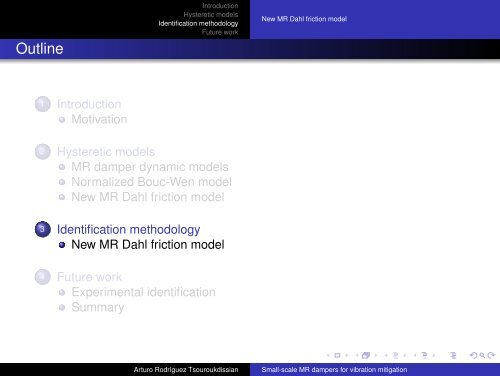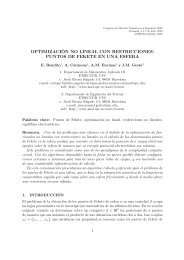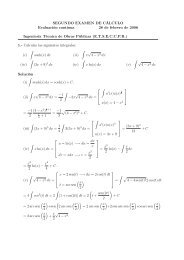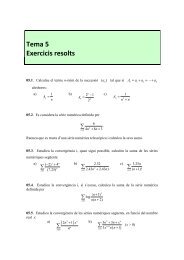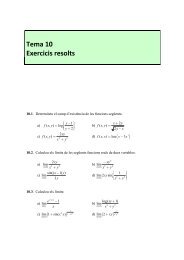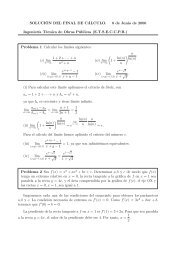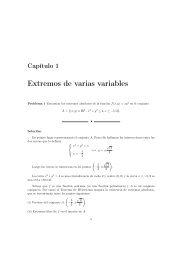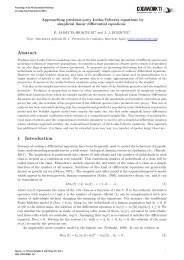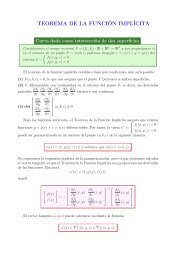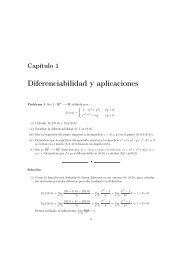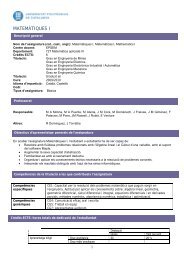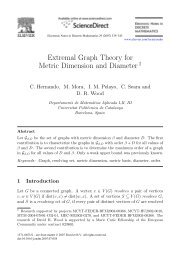Small-scale magnetorheological dampers for vibration mitigation ...
Small-scale magnetorheological dampers for vibration mitigation ...
Small-scale magnetorheological dampers for vibration mitigation ...
Create successful ePaper yourself
Turn your PDF publications into a flip-book with our unique Google optimized e-Paper software.
Outline<br />
Introduction<br />
Hysteretic models<br />
Identification methodology<br />
Future work<br />
New MR Dahl friction model<br />
1 Introduction<br />
Motivation<br />
2 Hysteretic models<br />
MR damper dynamic models<br />
Normalized Bouc-Wen model<br />
New MR Dahl friction model<br />
3 Identification methodology<br />
New MR Dahl friction model<br />
4 Future work<br />
Experimental identification<br />
Summary<br />
Arturo Rodríguez Tsouroukdissian<br />
<strong>Small</strong>-<strong>scale</strong> MR <strong>dampers</strong> <strong>for</strong> <strong>vibration</strong> <strong>mitigation</strong>
Introduction<br />
Hysteretic models<br />
Identification methodology<br />
Future work<br />
New MR Dahl friction model<br />
New MR Dahl friction model identification methodology steps<br />
Identification methodology steps<br />
Ikhouane et. al. Previous considerations<br />
Step 1 Excite the system with a T-periodic input signal convex in its loading part<br />
Step 2 Compute k x<br />
Proof<br />
¯F(T + ) + ¯F(0)<br />
k x =<br />
ẋ(0) + ẋ(T + )<br />
Step 3 Compute θ(x)<br />
Proof<br />
θ(τ) with τ ∈ [0, T + ] is now known, then<br />
k w¯w(τ) = ¯F(τ) − k xẋ(τ) θ(τ)<br />
k w¯w(x) = θ(x)<br />
Arturo Rodríguez Tsouroukdissian<br />
<strong>Small</strong>-<strong>scale</strong> MR <strong>dampers</strong> <strong>for</strong> <strong>vibration</strong> <strong>mitigation</strong>
Introduction<br />
Hysteretic models<br />
Identification methodology<br />
Future work<br />
New MR Dahl friction model<br />
New MR Dahl friction model identification methodology steps<br />
Identification methodology steps<br />
Ikhouane et. al. Previous considerations<br />
Step 1 Excite the system with a T-periodic input signal convex in its loading part<br />
Step 2 Compute k x<br />
Proof<br />
¯F(T + ) + ¯F(0)<br />
k x =<br />
ẋ(0) + ẋ(T + )<br />
Step 3 Compute θ(x)<br />
Proof<br />
θ(τ) with τ ∈ [0, T + ] is now known, then<br />
k w¯w(τ) = ¯F(τ) − k xẋ(τ) θ(τ)<br />
k w¯w(x) = θ(x)<br />
Arturo Rodríguez Tsouroukdissian<br />
<strong>Small</strong>-<strong>scale</strong> MR <strong>dampers</strong> <strong>for</strong> <strong>vibration</strong> <strong>mitigation</strong>
Introduction<br />
Hysteretic models<br />
Identification methodology<br />
Future work<br />
New MR Dahl friction model<br />
New MR Dahl friction model identification methodology steps<br />
Identification methodology steps<br />
Ikhouane et. al. Previous considerations<br />
Step 1 Excite the system with a T-periodic input signal convex in its loading part<br />
Step 2 Compute k x<br />
Proof<br />
¯F(T + ) + ¯F(0)<br />
k x =<br />
ẋ(0) + ẋ(T + )<br />
Step 3 Compute θ(x)<br />
Proof<br />
θ(τ) with τ ∈ [0, T + ] is now known, then<br />
k w¯w(τ) = ¯F(τ) − k xẋ(τ) θ(τ)<br />
k w¯w(x) = θ(x)<br />
Arturo Rodríguez Tsouroukdissian<br />
<strong>Small</strong>-<strong>scale</strong> MR <strong>dampers</strong> <strong>for</strong> <strong>vibration</strong> <strong>mitigation</strong>
Introduction<br />
Hysteretic models<br />
Identification methodology<br />
Future work<br />
New MR Dahl friction model<br />
New MR Dahl friction model identification methodology steps<br />
Identification methodology steps (Cont’d)<br />
Ikhouane et. al.<br />
Step 4 Determine the zero of the function θ(x), which is the quantity x ∗ such that θ(x ∗) = 0<br />
Step 5 Compute a by using<br />
( ) dθ(x)<br />
a =<br />
dx x=x∗<br />
Step 6 Choose 1 design parameter, which is x ∗1 ≥ x ∗<br />
Step 7 Compute k w and ρ<br />
( ) dθ(x)<br />
a −<br />
dx x=x<br />
ρ =<br />
∗1<br />
θ(x ∗1 )<br />
k w = a ρ<br />
Arturo Rodríguez Tsouroukdissian<br />
<strong>Small</strong>-<strong>scale</strong> MR <strong>dampers</strong> <strong>for</strong> <strong>vibration</strong> <strong>mitigation</strong>
Introduction<br />
Hysteretic models<br />
Identification methodology<br />
Future work<br />
New MR Dahl friction model<br />
New MR Dahl friction model identification methodology steps<br />
Identification methodology steps (Cont’d)<br />
Ikhouane et. al.<br />
Step 4 Determine the zero of the function θ(x), which is the quantity x ∗ such that θ(x ∗) = 0<br />
Step 5 Compute a by using<br />
( ) dθ(x)<br />
a =<br />
dx x=x∗<br />
Step 6 Choose 1 design parameter, which is x ∗1 ≥ x ∗<br />
Step 7 Compute k w and ρ<br />
( ) dθ(x)<br />
a −<br />
dx x=x<br />
ρ =<br />
∗1<br />
θ(x ∗1 )<br />
k w = a ρ<br />
Arturo Rodríguez Tsouroukdissian<br />
<strong>Small</strong>-<strong>scale</strong> MR <strong>dampers</strong> <strong>for</strong> <strong>vibration</strong> <strong>mitigation</strong>
Introduction<br />
Hysteretic models<br />
Identification methodology<br />
Future work<br />
New MR Dahl friction model<br />
New MR Dahl friction model identification methodology steps<br />
Identification methodology steps (Cont’d)<br />
Ikhouane et. al.<br />
Step 4 Determine the zero of the function θ(x), which is the quantity x ∗ such that θ(x ∗) = 0<br />
Step 5 Compute a by using<br />
( ) dθ(x)<br />
a =<br />
dx x=x∗<br />
Step 6 Choose 1 design parameter, which is x ∗1 ≥ x ∗<br />
Step 7 Compute k w and ρ<br />
( ) dθ(x)<br />
a −<br />
dx x=x<br />
ρ =<br />
∗1<br />
θ(x ∗1 )<br />
k w = a ρ<br />
Arturo Rodríguez Tsouroukdissian<br />
<strong>Small</strong>-<strong>scale</strong> MR <strong>dampers</strong> <strong>for</strong> <strong>vibration</strong> <strong>mitigation</strong>
Introduction<br />
Hysteretic models<br />
Identification methodology<br />
Future work<br />
New MR Dahl friction model<br />
New MR Dahl friction model identification methodology steps<br />
Identification methodology steps (Cont’d)<br />
Ikhouane et. al.<br />
Step 4 Determine the zero of the function θ(x), which is the quantity x ∗ such that θ(x ∗) = 0<br />
Step 5 Compute a by using<br />
( ) dθ(x)<br />
a =<br />
dx x=x∗<br />
Step 6 Choose 1 design parameter, which is x ∗1 ≥ x ∗<br />
Step 7 Compute k w and ρ<br />
( ) dθ(x)<br />
a −<br />
dx x=x<br />
ρ =<br />
∗1<br />
θ(x ∗1 )<br />
k w = a ρ<br />
Arturo Rodríguez Tsouroukdissian<br />
<strong>Small</strong>-<strong>scale</strong> MR <strong>dampers</strong> <strong>for</strong> <strong>vibration</strong> <strong>mitigation</strong>
Introduction<br />
Hysteretic models<br />
Identification methodology<br />
Future work<br />
New MR Dahl friction model simulation<br />
New MR Dahl friction model<br />
Results<br />
New MR Dahl friction model simulation under a convex input signal in its loading part<br />
Parameters Real Identified Relative error %<br />
k x 0.0320 0.0322 0.7722<br />
k w 5.4600 5.4591 0.0170<br />
ρ 600.0000 601.4496 0.2416<br />
Arturo Rodríguez Tsouroukdissian<br />
<strong>Small</strong>-<strong>scale</strong> MR <strong>dampers</strong> <strong>for</strong> <strong>vibration</strong> <strong>mitigation</strong>
Introduction<br />
Hysteretic models<br />
Identification methodology<br />
Future work<br />
New MR Dahl friction model simulation<br />
New MR Dahl friction model<br />
Results<br />
New MR Dahl friction model simulation under a convex input signal in its loading part<br />
Parameters Real Identified Relative error %<br />
k x 0.0320 0.0322 0.7722<br />
k w 5.4600 5.4591 0.0170<br />
ρ 600.0000 601.4496 0.2416<br />
Arturo Rodríguez Tsouroukdissian<br />
<strong>Small</strong>-<strong>scale</strong> MR <strong>dampers</strong> <strong>for</strong> <strong>vibration</strong> <strong>mitigation</strong>
Outline<br />
Introduction<br />
Hysteretic models<br />
Identification methodology<br />
Future work<br />
Experimental identification<br />
Summary<br />
1 Introduction<br />
Motivation<br />
2 Hysteretic models<br />
MR damper dynamic models<br />
Normalized Bouc-Wen model<br />
New MR Dahl friction model<br />
3 Identification methodology<br />
New MR Dahl friction model<br />
4 Future work<br />
Experimental identification<br />
Summary<br />
Arturo Rodríguez Tsouroukdissian<br />
<strong>Small</strong>-<strong>scale</strong> MR <strong>dampers</strong> <strong>for</strong> <strong>vibration</strong> <strong>mitigation</strong>
Introduction<br />
Hysteretic models<br />
Identification methodology<br />
Future work<br />
Experimental identification<br />
Summary<br />
Identification of a small-<strong>scale</strong> MR controllable-friction damper<br />
Main characteristics<br />
Chrzan and Carlson, 2001<br />
Enable low cost appropriate <strong>for</strong> less<br />
demanding, low-<strong>for</strong>ce applications with a high<br />
degree of control<br />
Consists in an absorbent foam saturated with<br />
MR fluid (aprox. 3 ml).<br />
Doesn’t have an accumulator and a bypass of<br />
the fluid.<br />
Operates in a direct shear mode without seals,<br />
bearings or precision mechanical tolerance.<br />
Technical data<br />
Arturo Rodríguez Tsouroukdissian<br />
<strong>Small</strong>-<strong>scale</strong> MR <strong>dampers</strong> <strong>for</strong> <strong>vibration</strong> <strong>mitigation</strong>
Introduction<br />
Hysteretic models<br />
Identification methodology<br />
Future work<br />
Experimental identification<br />
Summary<br />
Identification of a small-<strong>scale</strong> MR controllable-friction damper<br />
Main characteristics<br />
Chrzan and Carlson, 2001<br />
Enable low cost appropriate <strong>for</strong> less<br />
demanding, low-<strong>for</strong>ce applications with a high<br />
degree of control<br />
Consists in an absorbent foam saturated with<br />
MR fluid (aprox. 3 ml).<br />
Doesn’t have an accumulator and a bypass of<br />
the fluid.<br />
Operates in a direct shear mode without seals,<br />
bearings or precision mechanical tolerance.<br />
Technical data<br />
Arturo Rodríguez Tsouroukdissian<br />
<strong>Small</strong>-<strong>scale</strong> MR <strong>dampers</strong> <strong>for</strong> <strong>vibration</strong> <strong>mitigation</strong>
Introduction<br />
Hysteretic models<br />
Identification methodology<br />
Future work<br />
Experimental identification<br />
Summary<br />
Identification of a small-<strong>scale</strong> MR controllable-friction damper<br />
Main characteristics<br />
Chrzan and Carlson, 2001<br />
Enable low cost appropriate <strong>for</strong> less<br />
demanding, low-<strong>for</strong>ce applications with a high<br />
degree of control<br />
Consists in an absorbent foam saturated with<br />
MR fluid (aprox. 3 ml).<br />
Doesn’t have an accumulator and a bypass of<br />
the fluid.<br />
Operates in a direct shear mode without seals,<br />
bearings or precision mechanical tolerance.<br />
Technical data<br />
Arturo Rodríguez Tsouroukdissian<br />
<strong>Small</strong>-<strong>scale</strong> MR <strong>dampers</strong> <strong>for</strong> <strong>vibration</strong> <strong>mitigation</strong>
Introduction<br />
Hysteretic models<br />
Identification methodology<br />
Future work<br />
Experimental identification<br />
Summary<br />
Identification of a small-<strong>scale</strong> MR controllable-friction damper<br />
Main characteristics<br />
Chrzan and Carlson, 2001<br />
Enable low cost appropriate <strong>for</strong> less<br />
demanding, low-<strong>for</strong>ce applications with a high<br />
degree of control<br />
Consists in an absorbent foam saturated with<br />
MR fluid (aprox. 3 ml).<br />
Doesn’t have an accumulator and a bypass of<br />
the fluid.<br />
Operates in a direct shear mode without seals,<br />
bearings or precision mechanical tolerance.<br />
Technical data<br />
Arturo Rodríguez Tsouroukdissian<br />
<strong>Small</strong>-<strong>scale</strong> MR <strong>dampers</strong> <strong>for</strong> <strong>vibration</strong> <strong>mitigation</strong>
Introduction<br />
Hysteretic models<br />
Identification methodology<br />
Future work<br />
Experimental identification<br />
Summary<br />
Diagram of the identification experiment layout<br />
MR damper fixed on top of the Shake Table. The sensors used are: (i) a load cell, (ii) laser<br />
displacement, and (iii) accelerometer.<br />
Arturo Rodríguez Tsouroukdissian<br />
<strong>Small</strong>-<strong>scale</strong> MR <strong>dampers</strong> <strong>for</strong> <strong>vibration</strong> <strong>mitigation</strong>
Introduction<br />
Hysteretic models<br />
Identification methodology<br />
Future work<br />
Experimental identification<br />
Summary<br />
Identification of a small-<strong>scale</strong> MR controllable-friction damper tests<br />
Experimental input current<br />
From the shear-mode MR damper model, the modified Dahl model has to include the voltage as<br />
k x(v) = k xa + k xb v<br />
k w(v) = k wa + k wb v<br />
˙v = −η(v − u)<br />
η = positive constant, u = command voltage applied to the Wonder Box, and v = is a varying<br />
voltage. η can be determined if u is available as the system is linear.<br />
Loading experiments using constant and variable input current using a convex input signal in its<br />
loading part.<br />
Arturo Rodríguez Tsouroukdissian<br />
<strong>Small</strong>-<strong>scale</strong> MR <strong>dampers</strong> <strong>for</strong> <strong>vibration</strong> <strong>mitigation</strong>
Introduction<br />
Hysteretic models<br />
Identification methodology<br />
Future work<br />
Experimental identification<br />
Summary<br />
Identification of a small-<strong>scale</strong> MR controllable-friction damper tests<br />
Experimental input current<br />
From the shear-mode MR damper model, the modified Dahl model has to include the voltage as<br />
k x(v) = k xa + k xb v<br />
k w(v) = k wa + k wb v<br />
˙v = −η(v − u)<br />
η = positive constant, u = command voltage applied to the Wonder Box, and v = is a varying<br />
voltage. η can be determined if u is available as the system is linear.<br />
Loading experiments using constant and variable input current using a convex input signal in its<br />
loading part.<br />
Arturo Rodríguez Tsouroukdissian<br />
<strong>Small</strong>-<strong>scale</strong> MR <strong>dampers</strong> <strong>for</strong> <strong>vibration</strong> <strong>mitigation</strong>
Introduction<br />
Hysteretic models<br />
Identification methodology<br />
Future work<br />
Experimental identification<br />
Summary<br />
Identification of a small-<strong>scale</strong> MR controllable-friction damper tests<br />
Experimental input current<br />
From the shear-mode MR damper model, the modified Dahl model has to include the voltage as<br />
k x(v) = k xa + k xb v<br />
k w(v) = k wa + k wb v<br />
˙v = −η(v − u)<br />
η = positive constant, u = command voltage applied to the Wonder Box, and v = is a varying<br />
voltage. η can be determined if u is available as the system is linear.<br />
Loading experiments using constant and variable input current using a convex input signal in its<br />
loading part.<br />
Arturo Rodríguez Tsouroukdissian<br />
<strong>Small</strong>-<strong>scale</strong> MR <strong>dampers</strong> <strong>for</strong> <strong>vibration</strong> <strong>mitigation</strong>
Introduction<br />
Hysteretic models<br />
Identification methodology<br />
Future work<br />
Experimental identification<br />
Summary<br />
Identification of a large-<strong>scale</strong> MR controllable-fluid damper<br />
Main characteristics<br />
Yang et. al., 2004<br />
Real-time damping is controlled by the<br />
increase in yield stress of the MR fluid in<br />
response to magnetic field strength<br />
High dissipative <strong>for</strong>ce at low velocity<br />
Continual optimization<br />
High dynamic range<br />
Inherent stability and failure-safety<br />
Mechanical simplicity<br />
Fast response-time<br />
<strong>Small</strong> device size<br />
Large temperature range<br />
Arturo Rodríguez Tsouroukdissian<br />
<strong>Small</strong>-<strong>scale</strong> MR <strong>dampers</strong> <strong>for</strong> <strong>vibration</strong> <strong>mitigation</strong>
Introduction<br />
Hysteretic models<br />
Identification methodology<br />
Future work<br />
Experimental identification<br />
Summary<br />
Identification of a large-<strong>scale</strong> MR controllable-fluid damper<br />
Main characteristics<br />
Yang et. al., 2004<br />
Real-time damping is controlled by the<br />
increase in yield stress of the MR fluid in<br />
response to magnetic field strength<br />
High dissipative <strong>for</strong>ce at low velocity<br />
Continual optimization<br />
High dynamic range<br />
Inherent stability and failure-safety<br />
Mechanical simplicity<br />
Fast response-time<br />
<strong>Small</strong> device size<br />
Large temperature range<br />
Arturo Rodríguez Tsouroukdissian<br />
<strong>Small</strong>-<strong>scale</strong> MR <strong>dampers</strong> <strong>for</strong> <strong>vibration</strong> <strong>mitigation</strong>
Introduction<br />
Hysteretic models<br />
Identification methodology<br />
Future work<br />
Experimental identification<br />
Summary<br />
Identification of a large-<strong>scale</strong> MR controllable-fluid damper<br />
Main characteristics<br />
Yang et. al., 2004<br />
Real-time damping is controlled by the<br />
increase in yield stress of the MR fluid in<br />
response to magnetic field strength<br />
High dissipative <strong>for</strong>ce at low velocity<br />
Continual optimization<br />
High dynamic range<br />
Inherent stability and failure-safety<br />
Mechanical simplicity<br />
Fast response-time<br />
<strong>Small</strong> device size<br />
Large temperature range<br />
Arturo Rodríguez Tsouroukdissian<br />
<strong>Small</strong>-<strong>scale</strong> MR <strong>dampers</strong> <strong>for</strong> <strong>vibration</strong> <strong>mitigation</strong>
Introduction<br />
Hysteretic models<br />
Identification methodology<br />
Future work<br />
Experimental identification<br />
Summary<br />
Identification of a large-<strong>scale</strong> MR controllable-fluid damper<br />
Main characteristics<br />
Yang et. al., 2004<br />
Real-time damping is controlled by the<br />
increase in yield stress of the MR fluid in<br />
response to magnetic field strength<br />
High dissipative <strong>for</strong>ce at low velocity<br />
Continual optimization<br />
High dynamic range<br />
Inherent stability and failure-safety<br />
Mechanical simplicity<br />
Fast response-time<br />
<strong>Small</strong> device size<br />
Large temperature range<br />
Arturo Rodríguez Tsouroukdissian<br />
<strong>Small</strong>-<strong>scale</strong> MR <strong>dampers</strong> <strong>for</strong> <strong>vibration</strong> <strong>mitigation</strong>
Introduction<br />
Hysteretic models<br />
Identification methodology<br />
Future work<br />
Experimental identification<br />
Summary<br />
Identification of a large-<strong>scale</strong> MR controllable-fluid damper<br />
Main characteristics<br />
Yang et. al., 2004<br />
Real-time damping is controlled by the<br />
increase in yield stress of the MR fluid in<br />
response to magnetic field strength<br />
High dissipative <strong>for</strong>ce at low velocity<br />
Continual optimization<br />
High dynamic range<br />
Inherent stability and failure-safety<br />
Mechanical simplicity<br />
Fast response-time<br />
<strong>Small</strong> device size<br />
Large temperature range<br />
Arturo Rodríguez Tsouroukdissian<br />
<strong>Small</strong>-<strong>scale</strong> MR <strong>dampers</strong> <strong>for</strong> <strong>vibration</strong> <strong>mitigation</strong>
Introduction<br />
Hysteretic models<br />
Identification methodology<br />
Future work<br />
Experimental identification<br />
Summary<br />
Identification of a large-<strong>scale</strong> MR controllable-fluid damper<br />
Main characteristics<br />
Yang et. al., 2004<br />
Real-time damping is controlled by the<br />
increase in yield stress of the MR fluid in<br />
response to magnetic field strength<br />
High dissipative <strong>for</strong>ce at low velocity<br />
Continual optimization<br />
High dynamic range<br />
Inherent stability and failure-safety<br />
Mechanical simplicity<br />
Fast response-time<br />
<strong>Small</strong> device size<br />
Large temperature range<br />
Arturo Rodríguez Tsouroukdissian<br />
<strong>Small</strong>-<strong>scale</strong> MR <strong>dampers</strong> <strong>for</strong> <strong>vibration</strong> <strong>mitigation</strong>
Introduction<br />
Hysteretic models<br />
Identification methodology<br />
Future work<br />
Experimental identification<br />
Summary<br />
Identification of a large-<strong>scale</strong> MR controllable-fluid damper<br />
Main characteristics<br />
Yang et. al., 2004<br />
Real-time damping is controlled by the<br />
increase in yield stress of the MR fluid in<br />
response to magnetic field strength<br />
High dissipative <strong>for</strong>ce at low velocity<br />
Continual optimization<br />
High dynamic range<br />
Inherent stability and failure-safety<br />
Mechanical simplicity<br />
Fast response-time<br />
<strong>Small</strong> device size<br />
Large temperature range<br />
Arturo Rodríguez Tsouroukdissian<br />
<strong>Small</strong>-<strong>scale</strong> MR <strong>dampers</strong> <strong>for</strong> <strong>vibration</strong> <strong>mitigation</strong>
Introduction<br />
Hysteretic models<br />
Identification methodology<br />
Future work<br />
Experimental identification<br />
Summary<br />
Identification of a large-<strong>scale</strong> MR controllable-fluid damper<br />
Main characteristics<br />
Yang et. al., 2004<br />
Real-time damping is controlled by the<br />
increase in yield stress of the MR fluid in<br />
response to magnetic field strength<br />
High dissipative <strong>for</strong>ce at low velocity<br />
Continual optimization<br />
High dynamic range<br />
Inherent stability and failure-safety<br />
Mechanical simplicity<br />
Fast response-time<br />
<strong>Small</strong> device size<br />
Large temperature range<br />
Arturo Rodríguez Tsouroukdissian<br />
<strong>Small</strong>-<strong>scale</strong> MR <strong>dampers</strong> <strong>for</strong> <strong>vibration</strong> <strong>mitigation</strong>
Introduction<br />
Hysteretic models<br />
Identification methodology<br />
Future work<br />
Experimental identification<br />
Summary<br />
Identification of a large-<strong>scale</strong> MR controllable-fluid damper<br />
Main characteristics<br />
Yang et. al., 2004<br />
Real-time damping is controlled by the<br />
increase in yield stress of the MR fluid in<br />
response to magnetic field strength<br />
High dissipative <strong>for</strong>ce at low velocity<br />
Continual optimization<br />
High dynamic range<br />
Inherent stability and failure-safety<br />
Mechanical simplicity<br />
Fast response-time<br />
<strong>Small</strong> device size<br />
Large temperature range<br />
Arturo Rodríguez Tsouroukdissian<br />
<strong>Small</strong>-<strong>scale</strong> MR <strong>dampers</strong> <strong>for</strong> <strong>vibration</strong> <strong>mitigation</strong>
Outline<br />
Introduction<br />
Hysteretic models<br />
Identification methodology<br />
Future work<br />
Experimental identification<br />
Summary<br />
1 Introduction<br />
Motivation<br />
2 Hysteretic models<br />
MR damper dynamic models<br />
Normalized Bouc-Wen model<br />
New MR Dahl friction model<br />
3 Identification methodology<br />
New MR Dahl friction model<br />
4 Future work<br />
Experimental identification<br />
Summary<br />
Arturo Rodríguez Tsouroukdissian<br />
<strong>Small</strong>-<strong>scale</strong> MR <strong>dampers</strong> <strong>for</strong> <strong>vibration</strong> <strong>mitigation</strong>
Summary<br />
Introduction<br />
Hysteretic models<br />
Identification methodology<br />
Future work<br />
Experimental identification<br />
Summary<br />
Presentation summary<br />
Understand the dynamic behavior of the MR <strong>dampers</strong> with a feasible<br />
hysteretic model.<br />
Apply an identification methodology to the chosen hysteretic model.<br />
Outlook <strong>for</strong> future work<br />
To do the experimental identification of the small-<strong>scale</strong> controllable<br />
friction MR damper.<br />
To do the experimental identification of the large-<strong>scale</strong> controllable<br />
friction MR damper.<br />
Arturo Rodríguez Tsouroukdissian<br />
<strong>Small</strong>-<strong>scale</strong> MR <strong>dampers</strong> <strong>for</strong> <strong>vibration</strong> <strong>mitigation</strong>
Introduction<br />
Hysteretic models<br />
Identification methodology<br />
Future work<br />
Experimental identification<br />
Summary<br />
Muchas gracias<br />
Figure: Stenocutter - longest cable stayed bridge using MR <strong>dampers</strong> <strong>for</strong> cable<br />
<strong>vibration</strong> <strong>mitigation</strong>. Hong Kong, China<br />
Arturo Rodríguez Tsouroukdissian<br />
<strong>Small</strong>-<strong>scale</strong> MR <strong>dampers</strong> <strong>for</strong> <strong>vibration</strong> <strong>mitigation</strong>
Bibliography<br />
Introduction<br />
Hysteretic models<br />
Identification methodology<br />
Future work<br />
Experimental identification<br />
Summary<br />
Tsu T. Soong and B.F. Spencer.<br />
Supplemental energy dissipation: State-of-the-art and state-of-the-practice.<br />
Engineering Structures 24(1):243–259, 2002.<br />
Michael D. Symans and Michael C. Constantinou<br />
Return<br />
Development and experimental study of semi-active fluid damping devices <strong>for</strong> seismic protection of<br />
structures.<br />
National Center <strong>for</strong> Earthquake Engineering Research. Report No. NCEER 95-0011. Buffalo, NY. 1995<br />
Return<br />
G.W. Housner, L.A. Bergman, T.K. Caughey, A.G. Chassiakos, R.O. Claus, S.F. Masri, R.E. Skelton, T.T.<br />
Soong, B.F. Spencer, and J.T.P. Yao<br />
Structural control: Past, present, and future.<br />
Journal of Engineering Mechanics 123(9):897–971, 1997.<br />
S. Nagarajaiah and S. Sahasrabudhe<br />
Return<br />
Seismic response control of smart sliding isolated buildings using variable stiffness systems: An<br />
experimental and numerical study.<br />
Earthquake Engineering and Structural Dynamics 35(2):177–197, 2005.<br />
Return<br />
N. Makris and S. McMahon<br />
Structural control with controllable fluid <strong>dampers</strong>: Design and implementation issues.<br />
Proceedings of Second International Workshop on Structural Control. Hong Kong. 1996:311Ű-322<br />
Return<br />
Arturo Rodríguez Tsouroukdissian<br />
<strong>Small</strong>-<strong>scale</strong> MR <strong>dampers</strong> <strong>for</strong> <strong>vibration</strong> <strong>mitigation</strong>
Bibliography (Cont’d)<br />
Introduction<br />
Hysteretic models<br />
Identification methodology<br />
Future work<br />
Experimental identification<br />
Summary<br />
Dorka, U.E.<br />
Testing algorithms <strong>for</strong> semiactive control of bridges.<br />
Kassel, Germany. 2000 Return<br />
Villamizar Mejia, Rodolfo<br />
Robust control of systems subjected to uncertain disturbances and actuator dynamics.<br />
PhD Universitat de Girona. 2005 Return<br />
H. Fujitani, H. Sodeyama, T. Tomura, T. Hiwatashi, Y. Shiozaki, K.Hata, K.Sunakoda, S.Morishita, and S.Soda<br />
Development of 400kN <strong>magnetorheological</strong> damper <strong>for</strong> a real base-isolated building.<br />
SPIE - Conference on Smart Structures and Materials. Bellingham, Washington. 5027:265–276<br />
Return<br />
Stanway, R., Sproston, J.L., and Stevens, N.G.<br />
Non-linear Modelling of an Electrorheological Vibration Damper.<br />
Journal of Electrostatics. 1987(20):167Ű-184 Return<br />
D. R. Gamato and F. E. Filisko<br />
Dynamic mechanical studies of electrorheological materials: Moderate frequencies.<br />
Journal of Rheology. 1991(35):399–425 Return<br />
B.F. Spencer, S.J. Dyke, M.K. Sain, and J.D. Carlson<br />
Phenomenological model of a <strong>magnetorheological</strong> damper.<br />
ASCE Journal of Engineering Mechanics. 1997(123):230-238<br />
Return<br />
Arturo Rodríguez Tsouroukdissian<br />
<strong>Small</strong>-<strong>scale</strong> MR <strong>dampers</strong> <strong>for</strong> <strong>vibration</strong> <strong>mitigation</strong>
Bibliography (Cont’d)<br />
Introduction<br />
Hysteretic models<br />
Identification methodology<br />
Future work<br />
Experimental identification<br />
Summary<br />
Y.K. Wen<br />
Method of random <strong>vibration</strong> fo hysteretic systems.<br />
Journal of Engineering Mechanics. 1976(102):246–263<br />
Return<br />
Fayçal Ikhouane and José Rodellar<br />
On the hysteretic Bouc-Wen model. Part I: Forced limit cycle characterization.<br />
Nonlinear Dynamics. 2005(42):63–78 Return<br />
Fayçal Ikhouane and José Rodellar<br />
On the hysteretic Bouc-Wen model. Part II: Robust parametric identification.<br />
Nonlinear Dynamics. 2005(42):79–95 Return<br />
Fayçal Ikhouane, Victor Mañosa, and José Rodellar<br />
Dynamic properties of the hysteretic Bouc-Wen model.<br />
Sytems and Control Letters. 2006. in press Return<br />
Fayçal Ikhouane, Oriol Gomis-Bellmunt, and Pere Castell-Vilanova<br />
A limit cycle approach <strong>for</strong> the parametric identification of hysteretic systems.<br />
Submitted to IEEE - Control Systems Technology Return<br />
Fayçal Ikhouane and Shirley J. Dyke<br />
Modeling and identification of a shear mode <strong>magnetorheological</strong> damper.<br />
Submitted to Smart Materials and Structures Return<br />
Arturo Rodríguez Tsouroukdissian<br />
<strong>Small</strong>-<strong>scale</strong> MR <strong>dampers</strong> <strong>for</strong> <strong>vibration</strong> <strong>mitigation</strong>
Bibliography (Cont’d)<br />
Introduction<br />
Hysteretic models<br />
Identification methodology<br />
Future work<br />
Experimental identification<br />
Summary<br />
Silvano Erlicher and Nelly Point<br />
Thermodynamic admissibility of BoucŰWen type hysteresis models.<br />
Comptes Rendus Mecanique. 2004(332):51–57 Return<br />
Fayçal Ikhouane, José Rodellar, and José E. Hurtado<br />
Analytical characterization of hysteresis loops described by the Bouc-Wen model.<br />
Mechanics of Advanced Materials and Structures. 2006(13):463-472 Return<br />
P. R. Dahl<br />
A solid friction model.<br />
The Aerospace Corporation, El-Segundo, TOR-158(3107-18), Cali<strong>for</strong>nia. 1968<br />
Return<br />
F. Yi, S. J. Dyke, J. M. Caicedo, and J. D. Carlson.<br />
Experimental verification of multiinput seismic control strategies <strong>for</strong> smart <strong>dampers</strong>.<br />
ASCE Journal of Engineering Mechanics. 2001(127):1152–1164 Return<br />
LORD Corp.<br />
Rheonetic Magnetorheological (MR) Fluid Technology MR damper.<br />
Cary, NC Return<br />
Arturo Rodríguez Tsouroukdissian<br />
<strong>Small</strong>-<strong>scale</strong> MR <strong>dampers</strong> <strong>for</strong> <strong>vibration</strong> <strong>mitigation</strong>
Bibliography (Cont’d)<br />
Introduction<br />
Hysteretic models<br />
Identification methodology<br />
Future work<br />
Experimental identification<br />
Summary<br />
Michael J. Chrzan and J. David Carlson<br />
MR fluid sponge devices and their use in <strong>vibration</strong> control of washing machines.<br />
SPIE - 8th Annual Symposium on Smart Structures and Materials. Newport Beach, CA. 2001<br />
Return<br />
G. Yang, B.F. Spencer, J.D. Carlson, and M.K. Sain<br />
Large-<strong>scale</strong> MR fluid <strong>dampers</strong>: Modeling and dynamic per<strong>for</strong>mance considerations.<br />
Engineering Structures. 2002(24):309–323 Return<br />
G. Yang, B.F. Spencer, H.J. Jung, and J.D. Carlson<br />
Dynamic modeling of large-<strong>scale</strong> <strong>magnetorheological</strong> damper systems <strong>for</strong> civil engineering applications.<br />
Journal of Engineering Mechanics. 2004(130):1107–1114 Return<br />
Arturo Rodríguez Tsouroukdissian<br />
<strong>Small</strong>-<strong>scale</strong> MR <strong>dampers</strong> <strong>for</strong> <strong>vibration</strong> <strong>mitigation</strong>
Proofs<br />
Introduction<br />
Hysteretic models<br />
Identification methodology<br />
Future work<br />
Experimental identification<br />
Summary<br />
Proof.<br />
Demonstration of alternative to shear-mode MR damper<br />
Previous considerations<br />
Overparametrized → per<strong>for</strong>m normalization<br />
Ikhouane and Dyke<br />
The fact that lim ρ−→∞ ψ σ,n(¯x tp) = −1 is independent from σ and n <strong>for</strong> large values of ρX max<br />
Proof<br />
Conclusion → <strong>for</strong> large values of ρX max, the values of the parameters σ and n are irrelevant.<br />
After considering the previous alternatives a new model is suggested<br />
F(T) = k vẋ(t) + k vF c(ẋ)<br />
k x and k w are voltage dependent, and F c is the Coulomb dry friction <strong>for</strong>ce representation<br />
F c(ẋ) = 1 <strong>for</strong> ẋ > 0<br />
F c(ẋ) = −1 <strong>for</strong> ẋ < 0<br />
Disadvantage → discontinuity at zero velocity or numerical instability when the ẋ of the damper is<br />
close to 0<br />
Return<br />
Arturo Rodríguez Tsouroukdissian<br />
<strong>Small</strong>-<strong>scale</strong> MR <strong>dampers</strong> <strong>for</strong> <strong>vibration</strong> <strong>mitigation</strong>
Proofs<br />
Introduction<br />
Hysteretic models<br />
Identification methodology<br />
Future work<br />
Experimental identification<br />
Summary<br />
Proof.<br />
Demonstration of alternative to shear-mode MR damper<br />
Previous considerations<br />
Overparametrized → per<strong>for</strong>m normalization<br />
Ikhouane and Dyke<br />
The fact that lim ρ−→∞ ψ σ,n(¯x tp) = −1 is independent from σ and n <strong>for</strong> large values of ρX max<br />
Proof<br />
Conclusion → <strong>for</strong> large values of ρX max, the values of the parameters σ and n are irrelevant.<br />
After considering the previous alternatives a new model is suggested<br />
F(T) = k vẋ(t) + k vF c(ẋ)<br />
k x and k w are voltage dependent, and F c is the Coulomb dry friction <strong>for</strong>ce representation<br />
F c(ẋ) = 1 <strong>for</strong> ẋ > 0<br />
F c(ẋ) = −1 <strong>for</strong> ẋ < 0<br />
Disadvantage → discontinuity at zero velocity or numerical instability when the ẋ of the damper is<br />
close to 0<br />
Return<br />
Arturo Rodríguez Tsouroukdissian<br />
<strong>Small</strong>-<strong>scale</strong> MR <strong>dampers</strong> <strong>for</strong> <strong>vibration</strong> <strong>mitigation</strong>
Proofs<br />
Introduction<br />
Hysteretic models<br />
Identification methodology<br />
Future work<br />
Experimental identification<br />
Summary<br />
Proof.<br />
Demonstration of alternative to shear-mode MR damper<br />
Previous considerations<br />
Overparametrized → per<strong>for</strong>m normalization<br />
Ikhouane and Dyke<br />
The fact that lim ρ−→∞ ψ σ,n(¯x tp) = −1 is independent from σ and n <strong>for</strong> large values of ρX max<br />
Proof<br />
Conclusion → <strong>for</strong> large values of ρX max, the values of the parameters σ and n are irrelevant.<br />
After considering the previous alternatives a new model is suggested<br />
F(T) = k vẋ(t) + k vF c(ẋ)<br />
k x and k w are voltage dependent, and F c is the Coulomb dry friction <strong>for</strong>ce representation<br />
F c(ẋ) = 1 <strong>for</strong> ẋ > 0<br />
F c(ẋ) = −1 <strong>for</strong> ẋ < 0<br />
Disadvantage → discontinuity at zero velocity or numerical instability when the ẋ of the damper is<br />
close to 0<br />
Return<br />
Arturo Rodríguez Tsouroukdissian<br />
<strong>Small</strong>-<strong>scale</strong> MR <strong>dampers</strong> <strong>for</strong> <strong>vibration</strong> <strong>mitigation</strong>
Proofs<br />
Introduction<br />
Hysteretic models<br />
Identification methodology<br />
Future work<br />
Experimental identification<br />
Summary<br />
Proof.<br />
Demonstration of alternative to shear-mode MR damper<br />
Previous considerations<br />
Overparametrized → per<strong>for</strong>m normalization<br />
Ikhouane and Dyke<br />
The fact that lim ρ−→∞ ψ σ,n(¯x tp) = −1 is independent from σ and n <strong>for</strong> large values of ρX max<br />
Proof<br />
Conclusion → <strong>for</strong> large values of ρX max, the values of the parameters σ and n are irrelevant.<br />
After considering the previous alternatives a new model is suggested<br />
F(T) = k vẋ(t) + k vF c(ẋ)<br />
k x and k w are voltage dependent, and F c is the Coulomb dry friction <strong>for</strong>ce representation<br />
F c(ẋ) = 1 <strong>for</strong> ẋ > 0<br />
F c(ẋ) = −1 <strong>for</strong> ẋ < 0<br />
Disadvantage → discontinuity at zero velocity or numerical instability when the ẋ of the damper is<br />
close to 0<br />
Return<br />
Arturo Rodríguez Tsouroukdissian<br />
<strong>Small</strong>-<strong>scale</strong> MR <strong>dampers</strong> <strong>for</strong> <strong>vibration</strong> <strong>mitigation</strong>
Proofs<br />
Introduction<br />
Hysteretic models<br />
Identification methodology<br />
Future work<br />
Experimental identification<br />
Summary<br />
Proof.<br />
Demonstration of alternative to shear-mode MR damper<br />
Previous considerations<br />
Overparametrized → per<strong>for</strong>m normalization<br />
Ikhouane and Dyke<br />
The fact that lim ρ−→∞ ψ σ,n(¯x tp) = −1 is independent from σ and n <strong>for</strong> large values of ρX max<br />
Proof<br />
Conclusion → <strong>for</strong> large values of ρX max, the values of the parameters σ and n are irrelevant.<br />
After considering the previous alternatives a new model is suggested<br />
F(T) = k vẋ(t) + k vF c(ẋ)<br />
k x and k w are voltage dependent, and F c is the Coulomb dry friction <strong>for</strong>ce representation<br />
F c(ẋ) = 1 <strong>for</strong> ẋ > 0<br />
F c(ẋ) = −1 <strong>for</strong> ẋ < 0<br />
Disadvantage → discontinuity at zero velocity or numerical instability when the ẋ of the damper is<br />
close to 0<br />
Return<br />
Arturo Rodríguez Tsouroukdissian<br />
<strong>Small</strong>-<strong>scale</strong> MR <strong>dampers</strong> <strong>for</strong> <strong>vibration</strong> <strong>mitigation</strong>
Proofs<br />
Introduction<br />
Hysteretic models<br />
Identification methodology<br />
Future work<br />
Experimental identification<br />
Summary<br />
Proof.<br />
Demonstration of alternative to shear-mode MR damper<br />
Previous considerations<br />
Overparametrized → per<strong>for</strong>m normalization<br />
Ikhouane and Dyke<br />
The fact that lim ρ−→∞ ψ σ,n(¯x tp) = −1 is independent from σ and n <strong>for</strong> large values of ρX max<br />
Proof<br />
Conclusion → <strong>for</strong> large values of ρX max, the values of the parameters σ and n are irrelevant.<br />
After considering the previous alternatives a new model is suggested<br />
F(T) = k vẋ(t) + k vF c(ẋ)<br />
k x and k w are voltage dependent, and F c is the Coulomb dry friction <strong>for</strong>ce representation<br />
F c(ẋ) = 1 <strong>for</strong> ẋ > 0<br />
F c(ẋ) = −1 <strong>for</strong> ẋ < 0<br />
Disadvantage → discontinuity at zero velocity or numerical instability when the ẋ of the damper is<br />
close to 0<br />
Return<br />
Arturo Rodríguez Tsouroukdissian<br />
<strong>Small</strong>-<strong>scale</strong> MR <strong>dampers</strong> <strong>for</strong> <strong>vibration</strong> <strong>mitigation</strong>
Proofs (Cont’d)<br />
Introduction<br />
Hysteretic models<br />
Identification methodology<br />
Future work<br />
Experimental identification<br />
Summary<br />
Proof.<br />
Regions of the hysteresis BW loops Ikhouane et. al., 2006<br />
The main slope of the linear region is ρX max. This slope comes from d¯w(¯x) at the point of the loading<br />
d¯x<br />
part of the limit cycle where ¯w(¯x) = 0<br />
The abscissa of the point P tp where the plastic region starts is ¯x tp<br />
We have<br />
lim<br />
u−→∞ ψσ,n(u) = 1<br />
Return<br />
Arturo Rodríguez Tsouroukdissian<br />
<strong>Small</strong>-<strong>scale</strong> MR <strong>dampers</strong> <strong>for</strong> <strong>vibration</strong> <strong>mitigation</strong>
Proofs (Cont’d)<br />
Introduction<br />
Hysteretic models<br />
Identification methodology<br />
Future work<br />
Experimental identification<br />
Summary<br />
Proof.<br />
Regions of the hysteresis BW loops Ikhouane et. al., 2006<br />
The main slope of the linear region is ρX max. This slope comes from d¯w(¯x) at the point of the loading<br />
d¯x<br />
part of the limit cycle where ¯w(¯x) = 0<br />
The abscissa of the point P tp where the plastic region starts is ¯x tp<br />
We have<br />
lim<br />
u−→∞ ψσ,n(u) = 1<br />
Return<br />
Arturo Rodríguez Tsouroukdissian<br />
<strong>Small</strong>-<strong>scale</strong> MR <strong>dampers</strong> <strong>for</strong> <strong>vibration</strong> <strong>mitigation</strong>
Proofs (Cont’d)<br />
Introduction<br />
Hysteretic models<br />
Identification methodology<br />
Future work<br />
Experimental identification<br />
Summary<br />
Proof.<br />
Regions of the hysteresis BW loops Ikhouane et. al., 2006<br />
The main slope of the linear region is ρX max. This slope comes from d¯w(¯x) at the point of the loading<br />
d¯x<br />
part of the limit cycle where ¯w(¯x) = 0<br />
The abscissa of the point P tp where the plastic region starts is ¯x tp<br />
We have<br />
lim<br />
u−→∞ ψσ,n(u) = 1<br />
Return<br />
Arturo Rodríguez Tsouroukdissian<br />
<strong>Small</strong>-<strong>scale</strong> MR <strong>dampers</strong> <strong>for</strong> <strong>vibration</strong> <strong>mitigation</strong>
Proofs (Cont’d)<br />
Introduction<br />
Hysteretic models<br />
Identification methodology<br />
Future work<br />
Experimental identification<br />
Summary<br />
Proof.<br />
Proof shear mode<br />
The fact that lim ρ−→∞ ψ σ,n(¯x tp) = −1 is independent from σ and n <strong>for</strong> large values of ρX max<br />
1<br />
¯x tp ≈ −1 [ϕ + σ,n<br />
ρX ( n√ 1 − r 2 ) − ϕ + σ,n (−1)]<br />
max<br />
Return<br />
Arturo Rodríguez Tsouroukdissian<br />
<strong>Small</strong>-<strong>scale</strong> MR <strong>dampers</strong> <strong>for</strong> <strong>vibration</strong> <strong>mitigation</strong>
Proofs (Cont’d)<br />
Introduction<br />
Hysteretic models<br />
Identification methodology<br />
Future work<br />
Experimental identification<br />
Summary<br />
Proof.<br />
Previous considerations in the Identification Methodology<br />
Ikhouane and Rodellar, 2005b<br />
Assumes knowledge of the limit cycle → (x(τ), ¯F(τ)) by a variable τ ∈ [0, T]<br />
Only the loading part of the input signal is considered τ ∈ [0, T + ]<br />
The equation of the loading part is<br />
¯w(x) = ψ + σ,n (ϕ+ σ,n [−ψσ,n(ρ(Xmax − X min))] + ρ(x − X min ))<br />
Its derivative is<br />
Proof<br />
Theorem 1 shows that<br />
d¯w(x)<br />
= ρ(1 − ¯w(x))<br />
dx<br />
x = X min → τ = 0 → −ψ 1,1 (ρ(X max − X min ))<br />
x = X max → τ = T + → ψ 1,1 (ρ(X max − X min ))<br />
Return<br />
Arturo Rodríguez Tsouroukdissian<br />
<strong>Small</strong>-<strong>scale</strong> MR <strong>dampers</strong> <strong>for</strong> <strong>vibration</strong> <strong>mitigation</strong>
Proofs (Cont’d)<br />
Introduction<br />
Hysteretic models<br />
Identification methodology<br />
Future work<br />
Experimental identification<br />
Summary<br />
Proof.<br />
Previous considerations in the Identification Methodology<br />
Ikhouane and Rodellar, 2005b<br />
Assumes knowledge of the limit cycle → (x(τ), ¯F(τ)) by a variable τ ∈ [0, T]<br />
Only the loading part of the input signal is considered τ ∈ [0, T + ]<br />
The equation of the loading part is<br />
¯w(x) = ψ + σ,n (ϕ+ σ,n [−ψσ,n(ρ(Xmax − X min))] + ρ(x − X min ))<br />
Its derivative is<br />
Proof<br />
Theorem 1 shows that<br />
d¯w(x)<br />
= ρ(1 − ¯w(x))<br />
dx<br />
x = X min → τ = 0 → −ψ 1,1 (ρ(X max − X min ))<br />
x = X max → τ = T + → ψ 1,1 (ρ(X max − X min ))<br />
Return<br />
Arturo Rodríguez Tsouroukdissian<br />
<strong>Small</strong>-<strong>scale</strong> MR <strong>dampers</strong> <strong>for</strong> <strong>vibration</strong> <strong>mitigation</strong>
Proofs (Cont’d)<br />
Introduction<br />
Hysteretic models<br />
Identification methodology<br />
Future work<br />
Experimental identification<br />
Summary<br />
Proof.<br />
Previous considerations in the Identification Methodology<br />
Ikhouane and Rodellar, 2005b<br />
Assumes knowledge of the limit cycle → (x(τ), ¯F(τ)) by a variable τ ∈ [0, T]<br />
Only the loading part of the input signal is considered τ ∈ [0, T + ]<br />
The equation of the loading part is<br />
¯w(x) = ψ + σ,n (ϕ+ σ,n [−ψσ,n(ρ(Xmax − X min))] + ρ(x − X min ))<br />
Its derivative is<br />
Proof<br />
Theorem 1 shows that<br />
d¯w(x)<br />
= ρ(1 − ¯w(x))<br />
dx<br />
x = X min → τ = 0 → −ψ 1,1 (ρ(X max − X min ))<br />
x = X max → τ = T + → ψ 1,1 (ρ(X max − X min ))<br />
Return<br />
Arturo Rodríguez Tsouroukdissian<br />
<strong>Small</strong>-<strong>scale</strong> MR <strong>dampers</strong> <strong>for</strong> <strong>vibration</strong> <strong>mitigation</strong>
Proofs (Cont’d)<br />
Introduction<br />
Hysteretic models<br />
Identification methodology<br />
Future work<br />
Experimental identification<br />
Summary<br />
Proof.<br />
Previous considerations in the Identification Methodology<br />
Ikhouane and Rodellar, 2005b<br />
Assumes knowledge of the limit cycle → (x(τ), ¯F(τ)) by a variable τ ∈ [0, T]<br />
Only the loading part of the input signal is considered τ ∈ [0, T + ]<br />
The equation of the loading part is<br />
¯w(x) = ψ + σ,n (ϕ+ σ,n [−ψσ,n(ρ(Xmax − X min))] + ρ(x − X min ))<br />
Its derivative is<br />
Proof<br />
Theorem 1 shows that<br />
d¯w(x)<br />
= ρ(1 − ¯w(x))<br />
dx<br />
x = X min → τ = 0 → −ψ 1,1 (ρ(X max − X min ))<br />
x = X max → τ = T + → ψ 1,1 (ρ(X max − X min ))<br />
Return<br />
Arturo Rodríguez Tsouroukdissian<br />
<strong>Small</strong>-<strong>scale</strong> MR <strong>dampers</strong> <strong>for</strong> <strong>vibration</strong> <strong>mitigation</strong>
Proofs (Cont’d)<br />
Introduction<br />
Hysteretic models<br />
Identification methodology<br />
Future work<br />
Experimental identification<br />
Summary<br />
Proof.<br />
Previous considerations in the Identification Methodology<br />
Ikhouane and Rodellar, 2005b<br />
Assumes knowledge of the limit cycle → (x(τ), ¯F(τ)) by a variable τ ∈ [0, T]<br />
Only the loading part of the input signal is considered τ ∈ [0, T + ]<br />
The equation of the loading part is<br />
¯w(x) = ψ + σ,n (ϕ+ σ,n [−ψσ,n(ρ(Xmax − X min))] + ρ(x − X min ))<br />
Its derivative is<br />
Proof<br />
Theorem 1 shows that<br />
d¯w(x)<br />
= ρ(1 − ¯w(x))<br />
dx<br />
x = X min → τ = 0 → −ψ 1,1 (ρ(X max − X min ))<br />
x = X max → τ = T + → ψ 1,1 (ρ(X max − X min ))<br />
Return<br />
Arturo Rodríguez Tsouroukdissian<br />
<strong>Small</strong>-<strong>scale</strong> MR <strong>dampers</strong> <strong>for</strong> <strong>vibration</strong> <strong>mitigation</strong>
Proofs (Cont’d)<br />
Introduction<br />
Hysteretic models<br />
Identification methodology<br />
Future work<br />
Experimental identification<br />
Summary<br />
Proof.<br />
Derivative of the loading part of the limit cycle of the new MR Dahl friction model<br />
¯w(x) = ψ + σ,n (ϕ+ σ,n [−ψσ,n(ρ(Xmax − X min))] + ρ(x − X min ))<br />
} {{ }<br />
f (x)<br />
, where<br />
∂f (x)<br />
= ρ<br />
∂x<br />
Then by using the fact that the function ψ σ,n + is the inverse of the function ϕ+ σ,n the following relationship is true<br />
∂ψ σ,n + (f (x))<br />
∂x<br />
(<br />
∂f (x) ∂ψ<br />
+ )<br />
σ,n (u)<br />
= = ρ ∗<br />
(<br />
∂x ∂u<br />
⎜<br />
u=f (x) ⎝<br />
⎛<br />
∂ϕ + σ,n (v)<br />
∂v<br />
⎞<br />
1<br />
)<br />
⎟<br />
⎠<br />
v=ψ σ,n + (f (x))<br />
The fact that ψ σ,n + (f (x)) = ¯w(x) so the previous equation becomes<br />
⎛<br />
∂¯w(x)<br />
= ρ ∗<br />
(<br />
∂x ⎜<br />
⎝<br />
∂ϕ + σ,n (v)<br />
∂v<br />
1<br />
)<br />
v=¯w(x)<br />
⎞<br />
⎟<br />
⎠<br />
Return<br />
Arturo Rodríguez Tsouroukdissian<br />
<strong>Small</strong>-<strong>scale</strong> MR <strong>dampers</strong> <strong>for</strong> <strong>vibration</strong> <strong>mitigation</strong>
Proofs (Cont’d)<br />
Introduction<br />
Hysteretic models<br />
Identification methodology<br />
Future work<br />
Experimental identification<br />
Summary<br />
Proof.<br />
Step 2 k x demonstration<br />
x = X min<br />
¯F(0) = k xẋ(0) + k w¯w(x)<br />
x = X max<br />
¯F(T + ) = k xẋ(T + ) + k w¯w(x)<br />
¯F(0) = k xẋ(0) + k w(−ψ 1,1 (ρ(X max − X min ))) ¯F(T + ) = k xẋ(0) + k w(ψ 1,1 (ρ(X max − X min )))<br />
Then if we combine the previous equations we arrive at the parameter k x the following way<br />
−¯F(0) + k xẋ(0) = ¯F(T + ) − k xẋ(T + )<br />
¯F(T + ) + ¯F(0)<br />
k x =<br />
ẋ(0) + ẋ(T + )<br />
Return<br />
Arturo Rodríguez Tsouroukdissian<br />
<strong>Small</strong>-<strong>scale</strong> MR <strong>dampers</strong> <strong>for</strong> <strong>vibration</strong> <strong>mitigation</strong>
Proofs (Cont’d)<br />
Introduction<br />
Hysteretic models<br />
Identification methodology<br />
Future work<br />
Experimental identification<br />
Summary<br />
Proof.<br />
Step 3 θ(x) demonstration<br />
Then its derivative<br />
dθ(x)<br />
= k wρ(1 − w(x))<br />
dx<br />
Defining a = k wρ and b = ρ, the derivative can be rewritten as<br />
dθ(x)<br />
= a − ρθ(x)<br />
dx<br />
Return<br />
Arturo Rodríguez Tsouroukdissian<br />
<strong>Small</strong>-<strong>scale</strong> MR <strong>dampers</strong> <strong>for</strong> <strong>vibration</strong> <strong>mitigation</strong>
<strong>Small</strong>-<strong>scale</strong> technical data<br />
Introduction<br />
Hysteretic models<br />
Identification methodology<br />
Future work<br />
Experimental identification<br />
Summary<br />
Technical data of the small-<strong>scale</strong> MR friction<br />
controllable damper<br />
LORD Corp.<br />
Stroke = 58 mm, Weight = 0.48 Kg, Input<br />
current = 0.5 A (continuous) and = 1 A<br />
(intermittent), Resistance (ambient temp.)<br />
= 20Ω<br />
Operating temperature = 70 C<br />
Damper <strong>for</strong>ces (peak-to-peak) = 100 N (5<br />
cm/sec @ 1 A) and = 2 N (20 cm/sec @ 0 A)<br />
Disadvantage → do not apply more than 0.5 A<br />
<strong>for</strong> longer than 30 sec at a time, or heat buildup<br />
may melt the plastic shaft.<br />
Wonder Box → device to control the MR<br />
damper. Power supply = 12 V DC and 2 A DC,<br />
the PC voltage signal is from 0 to 5 V DC, and<br />
the output current is from 0 to 2 A DC.<br />
Return<br />
Arturo Rodríguez Tsouroukdissian<br />
<strong>Small</strong>-<strong>scale</strong> MR <strong>dampers</strong> <strong>for</strong> <strong>vibration</strong> <strong>mitigation</strong>
<strong>Small</strong>-<strong>scale</strong> technical data<br />
Introduction<br />
Hysteretic models<br />
Identification methodology<br />
Future work<br />
Experimental identification<br />
Summary<br />
Technical data of the small-<strong>scale</strong> MR friction<br />
controllable damper<br />
LORD Corp.<br />
Stroke = 58 mm, Weight = 0.48 Kg, Input<br />
current = 0.5 A (continuous) and = 1 A<br />
(intermittent), Resistance (ambient temp.)<br />
= 20Ω<br />
Operating temperature = 70 C<br />
Damper <strong>for</strong>ces (peak-to-peak) = 100 N (5<br />
cm/sec @ 1 A) and = 2 N (20 cm/sec @ 0 A)<br />
Disadvantage → do not apply more than 0.5 A<br />
<strong>for</strong> longer than 30 sec at a time, or heat buildup<br />
may melt the plastic shaft.<br />
Wonder Box → device to control the MR<br />
damper. Power supply = 12 V DC and 2 A DC,<br />
the PC voltage signal is from 0 to 5 V DC, and<br />
the output current is from 0 to 2 A DC.<br />
Return<br />
Arturo Rodríguez Tsouroukdissian<br />
<strong>Small</strong>-<strong>scale</strong> MR <strong>dampers</strong> <strong>for</strong> <strong>vibration</strong> <strong>mitigation</strong>
<strong>Small</strong>-<strong>scale</strong> technical data<br />
Introduction<br />
Hysteretic models<br />
Identification methodology<br />
Future work<br />
Experimental identification<br />
Summary<br />
Technical data of the small-<strong>scale</strong> MR friction<br />
controllable damper<br />
LORD Corp.<br />
Stroke = 58 mm, Weight = 0.48 Kg, Input<br />
current = 0.5 A (continuous) and = 1 A<br />
(intermittent), Resistance (ambient temp.)<br />
= 20Ω<br />
Operating temperature = 70 C<br />
Damper <strong>for</strong>ces (peak-to-peak) = 100 N (5<br />
cm/sec @ 1 A) and = 2 N (20 cm/sec @ 0 A)<br />
Disadvantage → do not apply more than 0.5 A<br />
<strong>for</strong> longer than 30 sec at a time, or heat buildup<br />
may melt the plastic shaft.<br />
Wonder Box → device to control the MR<br />
damper. Power supply = 12 V DC and 2 A DC,<br />
the PC voltage signal is from 0 to 5 V DC, and<br />
the output current is from 0 to 2 A DC.<br />
Return<br />
Arturo Rodríguez Tsouroukdissian<br />
<strong>Small</strong>-<strong>scale</strong> MR <strong>dampers</strong> <strong>for</strong> <strong>vibration</strong> <strong>mitigation</strong>
<strong>Small</strong>-<strong>scale</strong> technical data<br />
Introduction<br />
Hysteretic models<br />
Identification methodology<br />
Future work<br />
Experimental identification<br />
Summary<br />
Technical data of the small-<strong>scale</strong> MR friction<br />
controllable damper<br />
LORD Corp.<br />
Stroke = 58 mm, Weight = 0.48 Kg, Input<br />
current = 0.5 A (continuous) and = 1 A<br />
(intermittent), Resistance (ambient temp.)<br />
= 20Ω<br />
Operating temperature = 70 C<br />
Damper <strong>for</strong>ces (peak-to-peak) = 100 N (5<br />
cm/sec @ 1 A) and = 2 N (20 cm/sec @ 0 A)<br />
Disadvantage → do not apply more than 0.5 A<br />
<strong>for</strong> longer than 30 sec at a time, or heat buildup<br />
may melt the plastic shaft.<br />
Wonder Box → device to control the MR<br />
damper. Power supply = 12 V DC and 2 A DC,<br />
the PC voltage signal is from 0 to 5 V DC, and<br />
the output current is from 0 to 2 A DC.<br />
Return<br />
Arturo Rodríguez Tsouroukdissian<br />
<strong>Small</strong>-<strong>scale</strong> MR <strong>dampers</strong> <strong>for</strong> <strong>vibration</strong> <strong>mitigation</strong>
<strong>Small</strong>-<strong>scale</strong> technical data<br />
Introduction<br />
Hysteretic models<br />
Identification methodology<br />
Future work<br />
Experimental identification<br />
Summary<br />
Technical data of the small-<strong>scale</strong> MR friction<br />
controllable damper<br />
LORD Corp.<br />
Stroke = 58 mm, Weight = 0.48 Kg, Input<br />
current = 0.5 A (continuous) and = 1 A<br />
(intermittent), Resistance (ambient temp.)<br />
= 20Ω<br />
Operating temperature = 70 C<br />
Damper <strong>for</strong>ces (peak-to-peak) = 100 N (5<br />
cm/sec @ 1 A) and = 2 N (20 cm/sec @ 0 A)<br />
Disadvantage → do not apply more than 0.5 A<br />
<strong>for</strong> longer than 30 sec at a time, or heat buildup<br />
may melt the plastic shaft.<br />
Wonder Box → device to control the MR<br />
damper. Power supply = 12 V DC and 2 A DC,<br />
the PC voltage signal is from 0 to 5 V DC, and<br />
the output current is from 0 to 2 A DC.<br />
Return<br />
Arturo Rodríguez Tsouroukdissian<br />
<strong>Small</strong>-<strong>scale</strong> MR <strong>dampers</strong> <strong>for</strong> <strong>vibration</strong> <strong>mitigation</strong>


